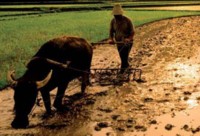Near Record High Food Prices Keep Poorest People on the Edge

the poorest people in the developing world at continued risk,
according to the World Bank Group’s Food Price Watch released
today.
While the emergency in the Horn of Africa was triggered by
prolonged droughts, especially in areas struggling with conflict
and internal displacement such as Somalia, food prices that are
near the record high levels seen in 2008 also contributed to the
situation, the report said.
Over the last three months, reportedly 29,000 children under
five have died in Somalia and 600,000 children in the region remain
at risk in the ongoing crisis that is threatening the lives and
livelihoods of more than 12 million people.
“Nowhere are high food prices, poverty and instability combining
to produce tragic suffering more than in the Horn of Africa,” said
World Bank President Robert B. Zoellick.
“The World Bank is stepping up with short term help through safety
nets to the poor and the vulnerable in places like Kenya and
Ethiopia, along with medium term support for economic recovery.
Long term support is also critical to build drought resilience and
implement climate-smart farming.”
The Food Price Watch says global food prices in July 2011 remain
significantly higher than a year ago. Prices overall remained 33
percent higher than a year ago with commodities such as maize (up
84 percent), sugar (up 62 percent), wheat (up 55 percent) and
soybean oil (up 47 percent) contributing to the increase. Crude oil
prices are 45 percent higher from July 2010 levels, affecting
production costs and the price of fertilizers, which increased by
67 percent over the same period.
Prices from April through July settled roughly five percent
below the recent spike in February 2011 due to modest declines in
grains, fats and oil, and other foods such as meat, fruits, and
sugar. However, prices of some commodities remained volatile during
this period. For example, maize and wheat prices declined in June
and then increased in the first half of July. The price of rice
fell from February to May, but has since increased.

“Persistently high food prices and low food stocks indicate that
we’re still in the danger zone, with the most vulnerable people the
least able to cope,” Zoellick said. “Vigilance is vital given the
uncertainties and volatility that exists today. There is no
cushion.”
The quarterly report warns that vigilance is needed as global
food stocks remain low and expected volatility in the prices of
sugar, rice, and petroleum products could have unexpected effects
on food prices in the months ahead. Uncertainties about the global
economy combined with the political situation in the Middle East
and North Africa region will likely to keep oil prices volatile in
the short term, it added.
Domestic food prices continued to be volatile across countries.
Maize prices, for instance, were up more than 100 percent in
Kampala, Mogadishu and Kigali markets in the 12 months to June;
while prices for maize fell 19 percent in Port-au-Prince and Mexico
City.
In the midst of these large price variations, domestic prices of
key staples increased sharply in a number of regions in the past
quarter, notably in Central and South America and East Africa. The
report also says sustained increases in food prices are driving up
inflation in a number of countries such as Ethiopia and Guatemala
among others.
In Somalia, prices of locally produced cereals have continued to
increase in all regions since October 2010 and have now exceeded
their 2008 peak levels. Prices of the two major commodities that
are domestically produced, red sorghum and white maize, have
increased up to 240 percent and 154 percent respectively. Prices of
imported commodities, such as rice, sugar, wheat flour, vegetable
oil, and petrol, are also higher than a year ago.
Out of 3.7 million people in crisis in Somalia, 3.2 million are
in urgent need and 2.8 million of these people are in the south.
Poor farmers with no stock and no means to purchase food are among
the worst affected, as are the displaced given their difficulties
accessing food. The urban poor are suffering from increases in the
cost of living and falling wages.
The World Bank Group is providing $686 million to save lives,
improve social protection, and foster economic recovery and drought
resilience for people in the Horn of Africa.
Initially, the Bank will target the most vulnerable by enhancing
safety nets. Economic recovery will be the focus over the next two
years. In the longer term, the Bank will focus on building
resilience to droughts, including investments in drought risk
reduction and risk financing, as well as climate-smart agricultural
practices.
“We are stepping up to address this crisis with a sense of
urgency,” said Zoellick, who has been advocating for the G20 to put
food first since the beginning of this year.
The G20 Agriculture Ministers meeting in June agreed to exempt
humanitarian food aid from export bans and to pilot small regional
emergency food reserves that could be used to replenish national
safety nets.
The ministers also agreed on more transparency, more
coordination, stronger risk management instruments and more
investment in production. The G20 Heads of State are due to meet on
these issues in November.
You can return to the main Market News page, or press the Back button on your browser.

